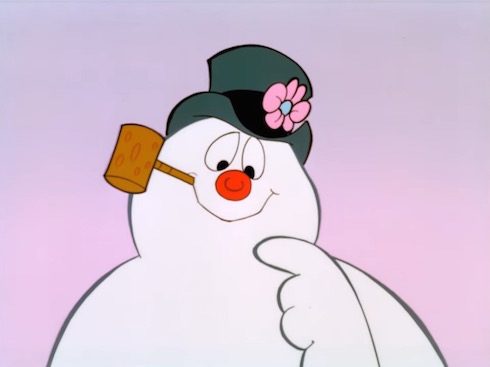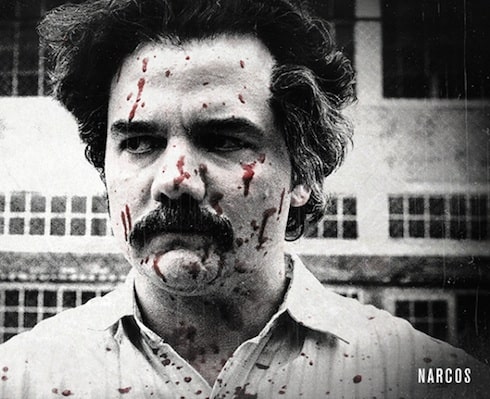Frosty the Snowman lives in the Sunken Place

I have a toddler, which means I spend a lot of time doing and watching the same things over and over. This year, despite being introduced to infinitely better fare, my child’s preferred holiday viewing is Frosty the Snowman. So I have seen our DVD transfer of the Frosty the Snowman that my mom recorded to VHS in 1987 more times this Christmas season than in all the other Christmas seasons of my life put together. And maybe the overload has warped me more than I yet realize. But please believe me when I tell you that Frosty the Snowman is a horror movie dressed up in puffy, kid-friendly clothes.
Frosty the Snowman is fun for kids and Get Out for their parents
Though he began life in 1950 as a Christmas song written specifically for Gene Autry, the best-known version of Frosty the Snowman has for generations been the animated special Rankin/Bass put out in 1969. Out of necessity, the special expands Frosty’s origin story before sending him on a grand adventure, one that when you get right down to it is a lot closer to Cormac McCarthy than to standard Christmas fare: Frosty, threatened by rising temperatures on one side and a hack magician trying to steal back the magic hat that gives Frosty life on the other, simply wants to survive.
Frosty the Snowman‘s purest moment of psychological terror occurs when Frosty comes to life for the second time. Hocus Pocus, the magician’s literal rabbit in a hat, has just returned the magic hat to the children, who put it back on Frosty’s head. Frosty promptly reanimates with a jubilant “Happy birthday!”, before demonstrating a surprising level of metacognition for an entity that we’ve been told only just came to life:
Hey! I said my first words! But — but snowmen can’t talk. [Laughs] Alright; come on now. What’s the joke? Could I really be alive? I mean — I can make words. [Does a little booty shake] I can move. [Starts tossing thrown snowballs] I can juggle. [Sweeps with his broom] I can sweep. I can count to ten: One, two, three, four, five, nine, six, eight….uh, well, I can count to five! [Touches his Frosty tummy and laughs] What’d y’know — I’m even ticklish. In fact — I’m all livin! I am alive! What a neat thing to happen to a nice guy like me.
Over the next few minutes, Frosty demonstrates that he also knows what thermometers are; what an increased temperature is and why it’s bad; why, conversely, the North Pole is “the only place [he’d] never melt”; what a town is, that there is one nearby, and that he’s “always wanted” to see it — and what parades are, as he suggests the children fall in line to make one on the way there.
Watch the scene once or twice a year and it turns into background noise; watch it a few times in a row with a little kid and it becomes charmingly familiar. But if you witness this mythological birthing more than that, you start to realize that Frosty, in his pre-snowman form, must be aware of everything happening around him at all times in order to know any of those things immediately upon being born. He doesn’t just know how to talk — he knows what talking is. He doesn’t just know how to count; he knows enough about the sequence of numbers to realize when he’s made a mistake. And he knows what both life and death are.
So the horrifying thing about Frosty the Snowman is that while he must be able to observe the world while lying on the ground as magical Christmas snow, he is completely unable to participate in anything that he sees until someone turns him into a snowman and plunks a magic silk hat upon his head. Unless both of those things happen, Frosty is just trapped in the Sunken Place without any way to let the friendly kids treading upon him as they leave school for the day know he’s in desperate need of their helping hands.
Once you’ve come this far in your analysis, it’s impossible to keep from thinking about the many implications of Christmas snow as a collective entity. Is all the snow that falls on Christmas in a pre-Frosty state, just waiting for the right magic hat to bring it to life? If you went across state lines and took all that snow and made thousands of snowmen out of it, and you had a magic silk hat for each one, would they all come to life? Would they each have their own personality? Or would you have thousands of different Frosties — some holly and jolly, some icy and cruel? Does all the Christmas snow stop being Frosty-worthy once one snowman comes to life? Or does it simply blanket the earth and wait patiently for the right children and the right hat to come along? If you have your ear to the ground when it melts, can you hear it scream?
The animated special adds the confusing twist of “Christmas snow” to the Frosty mythology
In this respect, the 1969 Frosty the Snowman special actually makes life much harder for Frosty than the 1950 song. Because the song relies only on good old magic (and the magic of the conditional “must”) to bring Frosty to life: “There must have been some magic / In that old silk hat they found / For when they placed it on his head / He began to dance around.”
But the Rankin/Bass special adds the self-invented twist of “Christmas snow” to the mix. Jimmy Durante — whose narration is a damn delight no matter how many times you hear it — explains the otherworldly significance of Christmas snow in the very first scene:
For it was the first snow of the season. And, as any child can tell you, there’s a certain magic to the very first snow. Especially when it falls on the day before Christmas. For when the first snow is also a Christmas snow [laughs]…well, something wonderful is bound to happen.
And Santa Claus expounds upon its powers after Frosty melts in the greenhouse near the end:
Frosty’s not gone for good. You see, he was made out of Christmas snow. And Christmas snow can never disappear completely. Oh, it sometimes goes away for almost a year at a time, and takes the form of spring and summer rain. But you can bet your boots that when a good, jolly December wind kisses it, it’ll turn into Christmas snow all over again.
But Christmas snow by itself does not a Frosty make. Only after the magic hat goes on his head does Frosty start his juggling and sweeping and aww-shucks routing. So it’s still unclear by the special’s end exactly why Frosty needs to be made of Christmas snow, or exactly what Christmas snow is. Does the first snow of the year have to fall on Christmas in order to qualify? Or can it just be any old White Christmas snow? Are Christmas Eve and Christmas Day both valid?
The special offers plenty of other nits to pick. Karen’s parents are completely absent and let her go to school in a snowstorm wearing no pants. Evil hack magician Professor Hinkle never suffers from the cold the way Karen does and has such strong lungs that he can blow out a campfire in a single breath. Frosty won’t build a fire for fear of melting, but five minutes later says he’ll stand with Karen in a greenhouse because he’s been meaning to lose some weight.
But these are all minor complaints or plotholes in comparison with the existential dread that is a veritable race of disjointed Christmas snow waiting voicelessly to be conjured into existence. Esquire recently proclaimed the best version of the song “Frosty the Snowman” to be The Partridge Family’s downbeat early 70s rendition, specifically because “whoever arranged it understood that the song is, at heart, a kind of murder ballad — the narrative of a beloved’s death.”
That “beloved” is meant to be Frosty himself, who understands his mortality from the moment of his birth. But it applies just as neatly to all the unrealized Frosties pleading for being in the hive mind-subconscious of their sole champion, who must turn away from them in order to prolong himself.
(Photo credits: Frosty the Snowman screengrab via Dreamworks Animation on YouTube)
John Sharp is a Starcasm’s chief editorial correspondent-at-large. Tips: E-mail john@starcasm.net or Twitter @john_starcasm.









